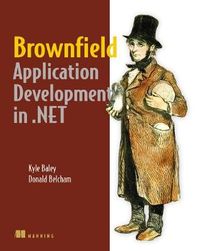
Brownfield Application Development in .NET Upplaga 1
HIGHLIGHT Developers learn to apply the same techniques they use for new application development to legacy apps. DESCRIPTION Most software developers have inherited legacy or brownfield projects that require maintenance, incremental improvements, or even cleaning up the mess another programmer left behind. Brownfield Application Development in .NET shows developers how to approach legacy applications with the state-of-the-art concepts, patterns, and tools developers apply to new projects. Using an existing application as an example, this book guides readers in applying the techniques and best practices they need to make a brownfield application more maintainable and receptive to change. As the book proceeds, the authors introduce frameworks and tools commonly used today while still approaching the subject from a conceptual level so that you can substitute alternate tools as appropriate. Because the book is based on the authors’ experiences, Brownfield Application Development in .NET moves beyond the theories and shows readers the techniques they need to be successful. KEY POINTS • Preparing for change • Challenges and goals in inheriting a project • Applying agile techniques—like testing and refactoring—to legacy apps MARKET INFORMATION Simply put, there are a lot more developers slogging through old legacy apps than there are creating new ones. Virtually all books on maintaining legacy apps address Java or C++ developers. This is the first book to tackle legacy applications from a .NET developer’s perspective.
Upplaga: 1a upplagan
Utgiven: 2010
ISBN: 9781933988719
Förlag: MANNING PUBLICATIONS
Format: Häftad
Språk: Engelska
Sidor: 390 st
HIGHLIGHT Developers learn to apply the same techniques they use for new application development to legacy apps. DESCRIPTION Most software developers have inherited legacy or brownfield projects that require maintenance, incremental improvements, or even cleaning up the mess another programmer left behind. Brownfield Application Development in .NET shows developers how to approach legacy applications with the state-of-the-art concepts, patterns, and tools developers apply to new projects. Using an existing application as an example, this book guides readers in applying the techniques and best practices they need to make a brownfield application more maintainable and receptive to change. As the book proceeds, the authors introduce frameworks and tools commonly used today while still approaching the subject from a conceptual level so that you can substitute alternate tools as appropriate. Because the book is based on the authors’ experiences, Brownfield Application Development in .NET moves beyond the theories and shows readers the techniques they need to be successful. KEY POINTS • Preparing for change • Challenges and goals in inheriting a project • Applying agile techniques—like testing and refactoring—to legacy apps MARKET INFORMATION Simply put, there are a lot more developers slogging through old legacy apps than there are creating new ones. Virtually all books on maintaining legacy apps address Java or C++ developers. This is the first book to tackle legacy applications from a .NET developer’s perspective.
Begagnad bok (0 st)
Varje vecka tillkommer tusentals nya säljare. Bevaka boken så får du meddelande när den finns tillgänglig igen.



